Abstract
1. To study the lymph flow dynamics in the intact thoracic duct, we applied an ultrasound transit-time flow probe in seven anaesthetized and four unanaesthetized adult sheep (approximately 60 kg). In unanaesthetized non-fasting animals we found that lymph flow in the thoracic duct was always regular pulsatile (pulsation frequency, 5.2 +/- 0.8 min-1) with no relation to heart or respiratory activity. At baseline the peak level of the thoracic duct pulse flow was 11.6-20.7 ml min-1 with a nadir of 0-3.6 ml min-1. Mean lymph flow was 5.4 +/- 3.1 ml min-1. The flow pattern of lymph in the thoracic duct was essentially the same in the anaesthetized animals. 2. In both the anaesthetized and unanaesthetized animals, the lymph flow response to a stepwise increase in the outflow venous pressure showed interindividual variation. Some were sensitive to any increase in outflow venous pressure, but others were resistant in that lymph flow did not decrease until outflow venous pressure was increased to higher levels. This resistance was also observed in the high lymph flow condition produced by fluid infusion in the anaesthetized animal and mechanical constriction of the caudal vena cava in the unaesthetized animals. Pulsation frequency of the thoracic duct flow initially increased and then decreased with a stepwise increase in the outflow venous pressure. This initial increase might be a compensatory response to maintain lymph flow against elevated outflow venous pressure. 3. To test the effect of long-term outflow venous pressure elevation in unanaesthetized sheep, outflow venous pressure was increased by inflation of a cuff around the cranial vena cava for 1, 5 or 25 h. The cuff was inflated to a level where lymph flow was reduced. Lymph flow remained low or decreased further during the entire cuff-inflation period. We calculated the lymph debt caused by the outflow venous pressure elevation and the amount 'repaid' when venous pressure returned to normal. Lymph debt for 25 h was 6400 ml but only 200 ml was repaid. Since we observed no visible oedema formation in the lower body of the sheep, the non-colloidal components of the lymph must have been reabsorbed into the bloodstream, most likely in the lymph nodes.
Full text
PDF

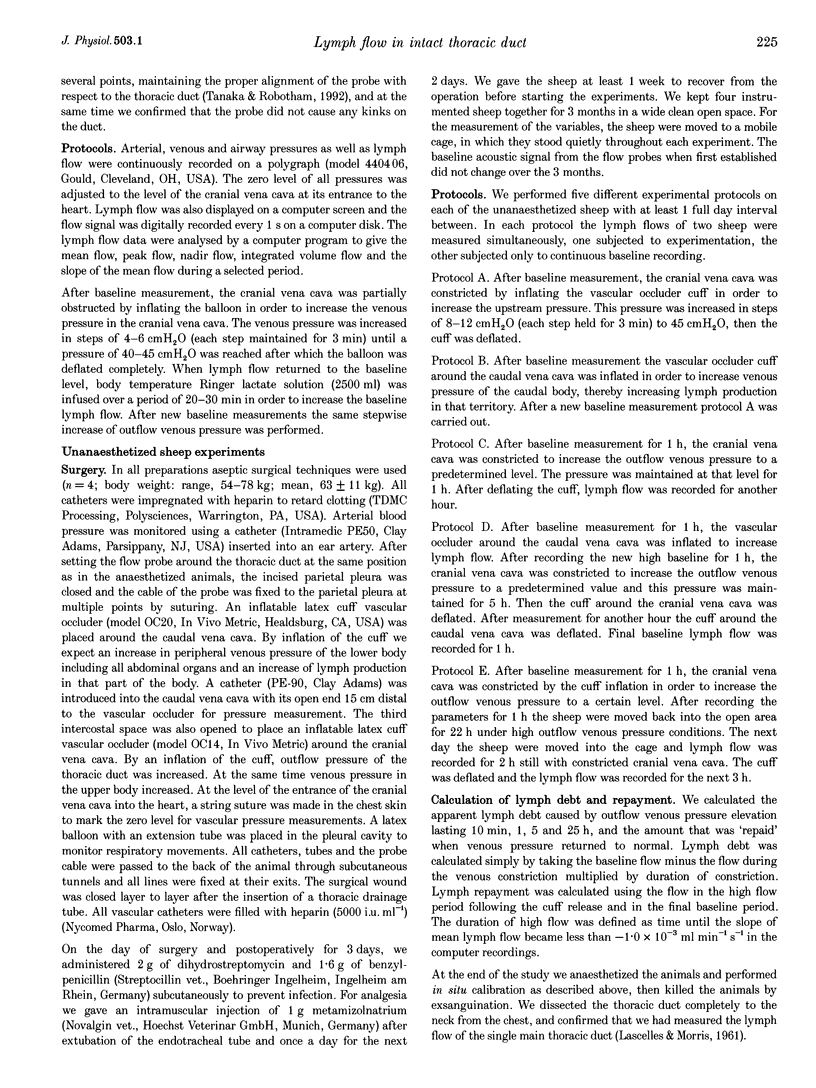


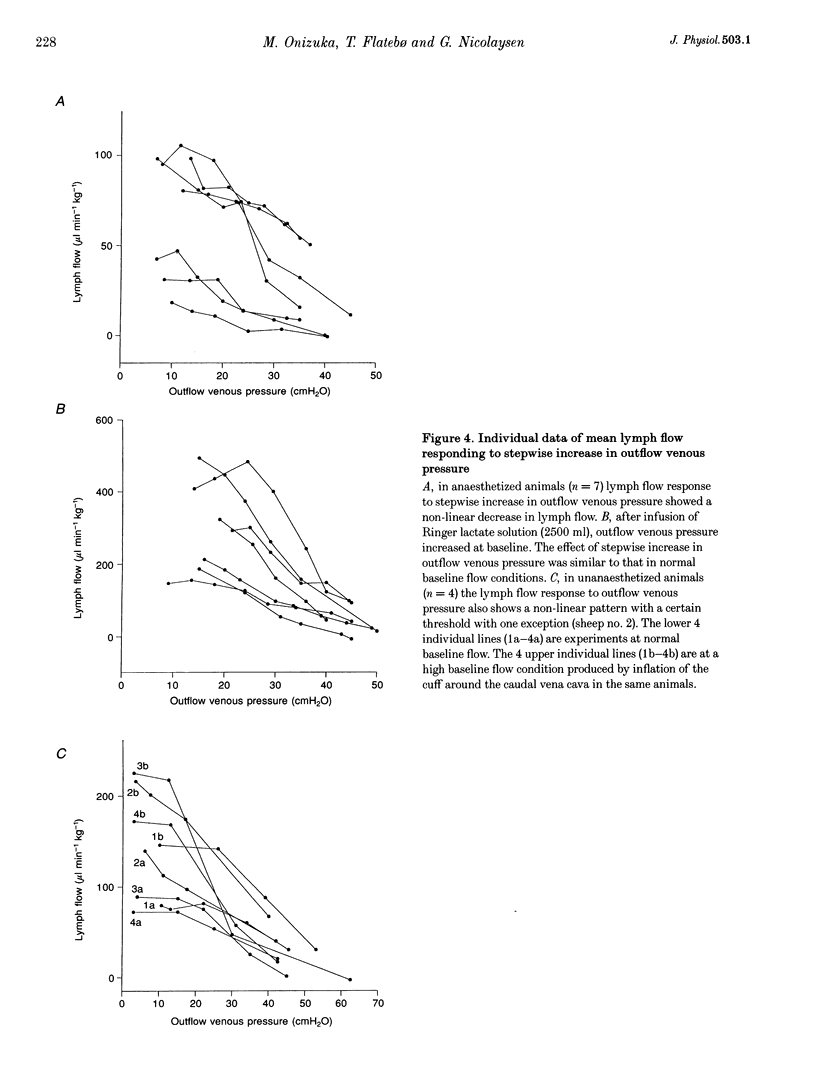



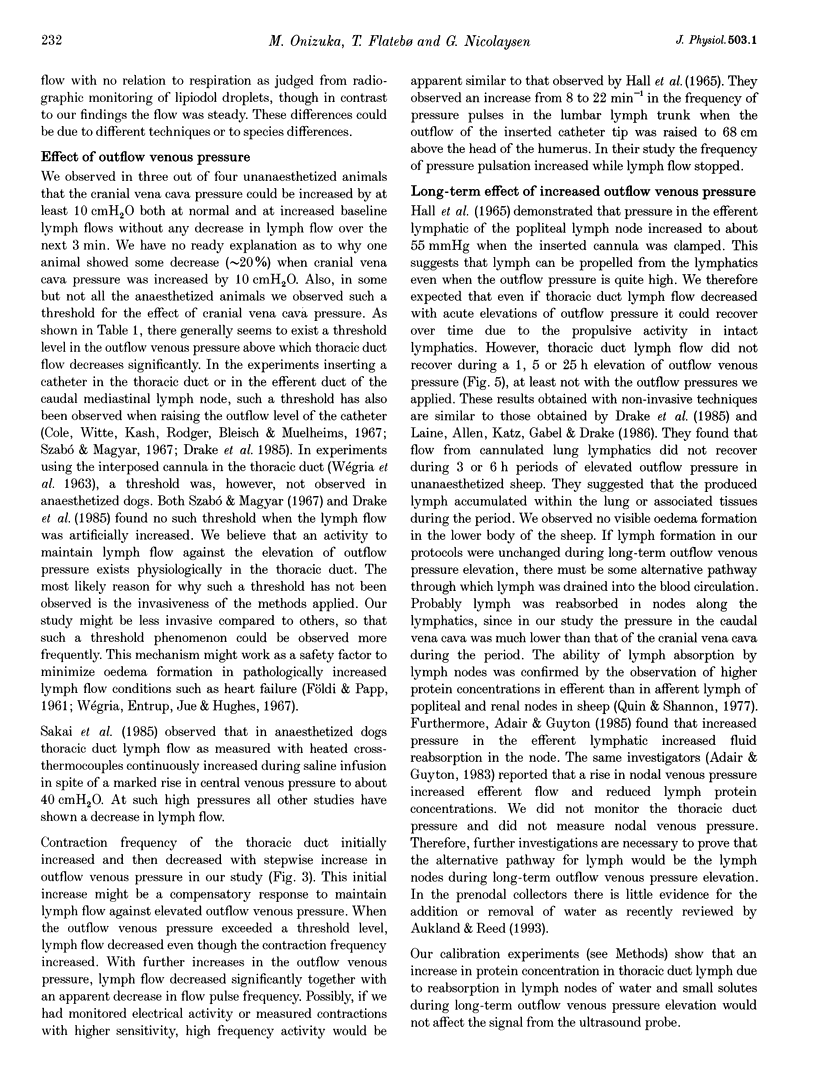
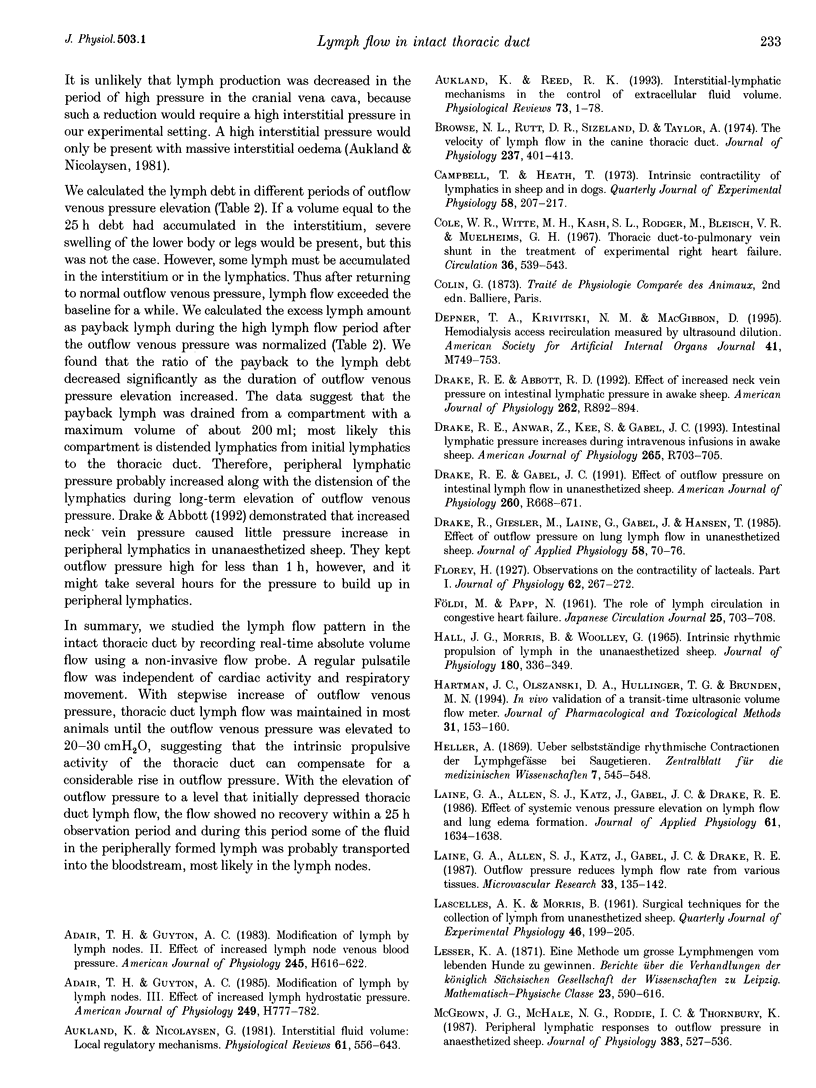
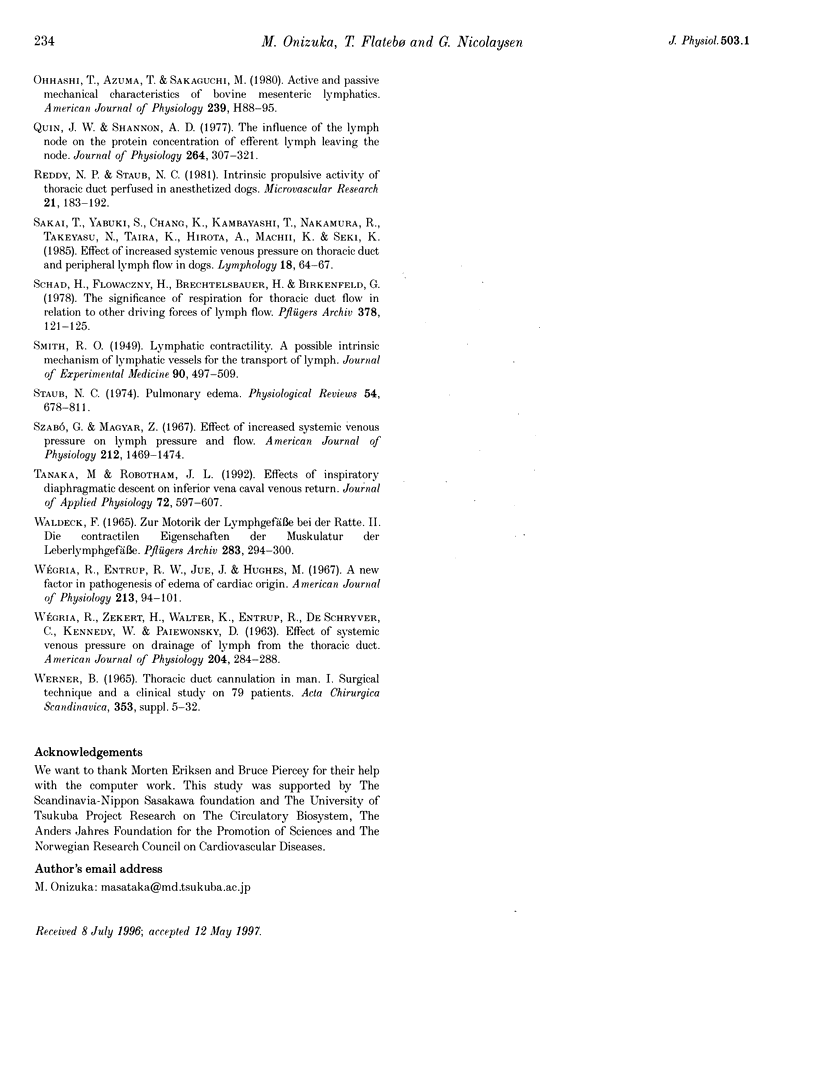
Selected References
These references are in PubMed. This may not be the complete list of references from this article.
- Adair T. H., Guyton A. C. Modification of lymph by lymph nodes. II. Effect of increased lymph node venous blood pressure. Am J Physiol. 1983 Oct;245(4):H616–H622. doi: 10.1152/ajpheart.1983.245.4.H616. [DOI] [PubMed] [Google Scholar]
- Adair T. H., Guyton A. C. Modification of lymph by lymph nodes. III. Effect of increased lymph hydrostatic pressure. Am J Physiol. 1985 Oct;249(4 Pt 2):H777–H782. doi: 10.1152/ajpheart.1985.249.4.H777. [DOI] [PubMed] [Google Scholar]
- Aukland K., Nicolaysen G. Interstitial fluid volume: local regulatory mechanisms. Physiol Rev. 1981 Jul;61(3):556–643. doi: 10.1152/physrev.1981.61.3.556. [DOI] [PubMed] [Google Scholar]
- Aukland K., Reed R. K. Interstitial-lymphatic mechanisms in the control of extracellular fluid volume. Physiol Rev. 1993 Jan;73(1):1–78. doi: 10.1152/physrev.1993.73.1.1. [DOI] [PubMed] [Google Scholar]
- Browse N. L., Rutt D. R., Sizeland D., Taylor A. The velocity of lymph flow in the canine thoracic duct. J Physiol. 1974 Mar;237(2):401–413. doi: 10.1113/jphysiol.1974.sp010488. [DOI] [PMC free article] [PubMed] [Google Scholar]
- Campbell T., Heath T. Intrinsic contractility of lymphatics in sheep and in dogs. Q J Exp Physiol Cogn Med Sci. 1973 Jul;58(3):207–217. doi: 10.1113/expphysiol.1973.sp002209. [DOI] [PubMed] [Google Scholar]
- Cole W. R., Witte M. H., Kash S. L., Rodger M., Bleisch W. R., Muelheims G. H. Thoracic duct-to-pulmonary vein shunt in the treatment of experimental right heart failure. Circulation. 1967 Oct;36(4):539–543. doi: 10.1161/01.cir.36.4.539. [DOI] [PubMed] [Google Scholar]
- Depner T. A., Krivitski N. M., MacGibbon D. Hemodialysis access recirculation measured by ultrasound dilution. ASAIO J. 1995 Jul-Sep;41(3):M749–M753. doi: 10.1097/00002480-199507000-00113. [DOI] [PubMed] [Google Scholar]
- Drake R. E., Abbott R. D. Effect of increased neck vein pressure on intestinal lymphatic pressure in awake sheep. Am J Physiol. 1992 May;262(5 Pt 2):R892–R894. doi: 10.1152/ajpregu.1992.262.5.R892. [DOI] [PubMed] [Google Scholar]
- Drake R. E., Anwar Z., Kee S., Gabel J. C. Intestinal lymphatic pressure increases during intravenous infusions in awake sheep. Am J Physiol. 1993 Sep;265(3 Pt 2):R703–R705. doi: 10.1152/ajpregu.1993.265.3.R703. [DOI] [PubMed] [Google Scholar]
- Drake R. E., Gabel J. C. Effect of outflow pressure on intestinal lymph flow in unanesthetized sheep. Am J Physiol. 1991 Apr;260(4 Pt 2):R668–R671. doi: 10.1152/ajpregu.1991.260.4.R668. [DOI] [PubMed] [Google Scholar]
- Drake R., Giesler M., Laine G., Gabel J., Hansen T. Effect of outflow pressure on lung lymph flow in unanesthetized sheep. J Appl Physiol (1985) 1985 Jan;58(1):70–76. doi: 10.1152/jappl.1985.58.1.70. [DOI] [PubMed] [Google Scholar]
- Florey H. Observations on the contractility of lacteals: Part I. J Physiol. 1927 Jan 12;62(3):267–272. doi: 10.1113/jphysiol.1927.sp002357. [DOI] [PMC free article] [PubMed] [Google Scholar]
- Hall J. G., Morris B., Woolley G. Intrinsic rhythmic propulsion of lymph in the unanaesthetized sheep. J Physiol. 1965 Sep;180(2):336–349. doi: 10.1113/jphysiol.1965.sp007706. [DOI] [PMC free article] [PubMed] [Google Scholar]
- Hartman J. C., Olszanski D. A., Hullinger T. G., Brunden M. N. In vivo validation of a transit-time ultrasonic volume flow meter. J Pharmacol Toxicol Methods. 1994 Jun;31(3):153–160. doi: 10.1016/1056-8719(94)90078-7. [DOI] [PubMed] [Google Scholar]
- LASCELLES A. K., MORRIS B. Surgical techniques for the collection of lymph from unanaesthetized sheep. Q J Exp Physiol Cogn Med Sci. 1961 Jul;46:199–205. doi: 10.1113/expphysiol.1961.sp001536. [DOI] [PubMed] [Google Scholar]
- Laine G. A., Allen S. J., Katz J., Gabel J. C., Drake R. E. Effect of systemic venous pressure elevation on lymph flow and lung edema formation. J Appl Physiol (1985) 1986 Nov;61(5):1634–1638. doi: 10.1152/jappl.1986.61.5.1634. [DOI] [PubMed] [Google Scholar]
- Laine G. A., Allen S. J., Katz J., Gabel J. C., Drake R. E. Outflow pressure reduces lymph flow rate from various tissues. Microvasc Res. 1987 Jan;33(1):135–142. doi: 10.1016/0026-2862(87)90012-4. [DOI] [PubMed] [Google Scholar]
- McGeown J. G., McHale N. G., Roddie I. C., Thornbury K. Peripheral lymphatic responses to outflow pressure in anaesthetized sheep. J Physiol. 1987 Feb;383:527–536. doi: 10.1113/jphysiol.1987.sp016426. [DOI] [PMC free article] [PubMed] [Google Scholar]
- Ohhashi T., Azuma T., Sakaguchi M. Active and passive mechanical characteristics of bovine mesenteric lymphatics. Am J Physiol. 1980 Jul;239(1):H88–H95. doi: 10.1152/ajpheart.1980.239.1.H88. [DOI] [PubMed] [Google Scholar]
- Quin J. W., Shannon A. D. The influence of the lymph node on the protein concentration of efferent lymph leaving the node. J Physiol. 1977 Jan;264(2):307–321. doi: 10.1113/jphysiol.1977.sp011670. [DOI] [PMC free article] [PubMed] [Google Scholar]
- Reddy N. P., Staub N. C. Intrinsic propulsive activity of thoracic duct perfused in anesthetized dogs. Microvasc Res. 1981 Mar;21(2):183–192. doi: 10.1016/0026-2862(81)90031-5. [DOI] [PubMed] [Google Scholar]
- Sakai T., Yabuki S., Chang K., Kambayashi T., Nakamura R., Takeyasu N., Taira K., Hirota A., Machii K., Seki K. Effect of increased systemic venous pressure on thoracic duct and peripheral lymph flow in dogs. Lymphology. 1985 Jun;18(2):64–67. [PubMed] [Google Scholar]
- Schad H., Flowaczny H., Brechtelsbauer H., Birkenfeld G. The significance of respiration for thoracic duct flow in relation to other driving forces of lymph flow. Pflugers Arch. 1978 Dec 28;378(2):121–125. doi: 10.1007/BF00584444. [DOI] [PubMed] [Google Scholar]
- Staub N. C. Pulmonary edema. Physiol Rev. 1974 Jul;54(3):678–811. doi: 10.1152/physrev.1974.54.3.678. [DOI] [PubMed] [Google Scholar]
- Szabó G., Magyar Z. Effect of increased systemic venous pressure on lymph pressure and flow. Am J Physiol. 1967 Jun;212(6):1469–1474. doi: 10.1152/ajplegacy.1967.212.6.1469. [DOI] [PubMed] [Google Scholar]
- Takata M., Robotham J. L. Effects of inspiratory diaphragmatic descent on inferior vena caval venous return. J Appl Physiol (1985) 1992 Feb;72(2):597–607. doi: 10.1152/jappl.1992.72.2.597. [DOI] [PubMed] [Google Scholar]
- WALDECK F. ZUR MOTORIK DER LYMPHGEFAESSE BEI DER RATTE. II. DIE CONTRACTILEN EIGENSCHAFTEN DER MUSKULATUR DER LEBERLYMPHGEFAESSE. Pflugers Arch Gesamte Physiol Menschen Tiere. 1965 Apr 15;283:294–300. [PubMed] [Google Scholar]
- WEGRIA R., ZEKERT H., WALTER K. E., ENTRUP R. W., DE SCHRYVER C., KENNEDY W., PAIEWONSKY D. Effect of systemic venous pressure on drainage of lymph from thoracic duct. Am J Physiol. 1963 Feb;204:284–288. doi: 10.1152/ajplegacy.1963.204.2.284. [DOI] [PubMed] [Google Scholar]
- Wégria R., Entrup R. W., Jue J., Hughes M. A new factor in pathogenesis of edema of cardiac origin. Am J Physiol. 1967 Jul;213(1):94–101. doi: 10.1152/ajplegacy.1967.213.1.94. [DOI] [PubMed] [Google Scholar]


